We’ve subsisted for months on morsels of information coming from ESA’s mission to Comet 67P/Churyumov-Gerasimenko. Now, a series of scientific papers in journal Science offers a much more complete, if preliminary, look at Rosetta’s comet. And what a wonderful and complex world it is.
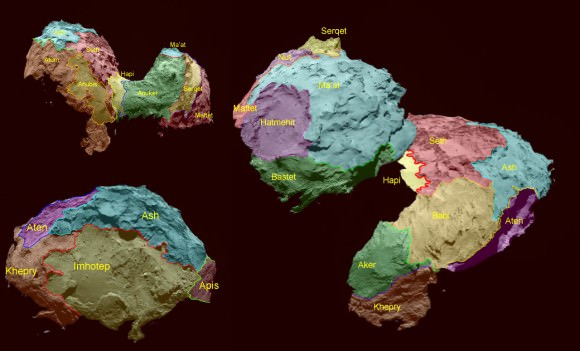
Each of the papers describes a different aspect of the comet from the size and density of dust particles jetting from the nucleus, organic materials found on its surface and the diverse geology of its bizarre landscapes. Surprises include finding no firm evidence yet of ice on the comet’s nucleus. There’s no question water and other ices compose much of 67P’s 10 billion ton mass, but much of it’s buried under a thick layer of dust.
Despite its solid appearance, 67P is highly porous with a density similar to wood or cork and orbited by a cloud of approximately 100,000 “grains” of material larger than 2 inches (5 cm) across stranded there after the comet’s previous perihelion passage. Thousands of tiny comet-lets!
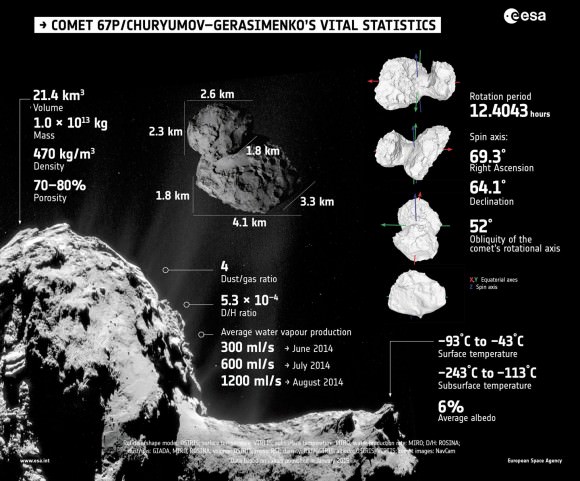
Researchers have identified 19 distinct geological regions on the comet and five basic types of terrain: dust-covered, brittle material, large-scale depressions, smooth terrains and consolidated surfaces.
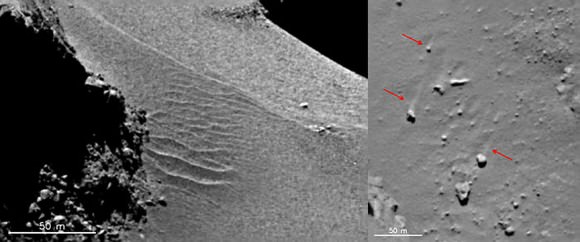
The Ma’at and Ash regions (in blue above) are buried in 3 to 15 feet of dust that once filled the comet’s coma and then slowly settled back to the surface. High resolution images show dune-like structures, ripples and rocks with wind tails. Winds on a comet? It’s thought that sublimating (vaporizing) CO and CO2 ice beneath the surface vents to the surface with a force strong enough to create fleeting gusty winds in the comet’s low gravity, lifting and moving dust across the landscape. Electrostatic levitation of dust charged by sunlight may also play a role.
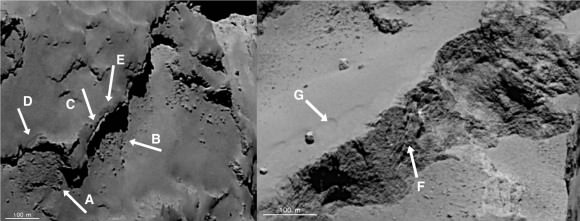
The Seth and Imhotep regions are rich with brittle material liable to fracture and collapse when ices beneath them vaporize in sunlight to create voids. Given the comet’s extremely low gravity field, 67P must be composed of very fragile material for it to fall apart with such ease. Air candy anyone?
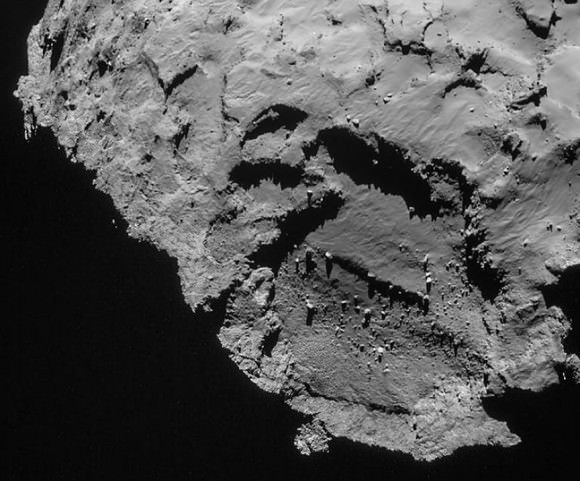
No impact craters have been positively identified yet, but the comet’s head and body each have a large, circular depression that may or may not be related to impact. Hatmehit, about 1 km in diameter, is located on the head of the nucleus with Aten on the body.
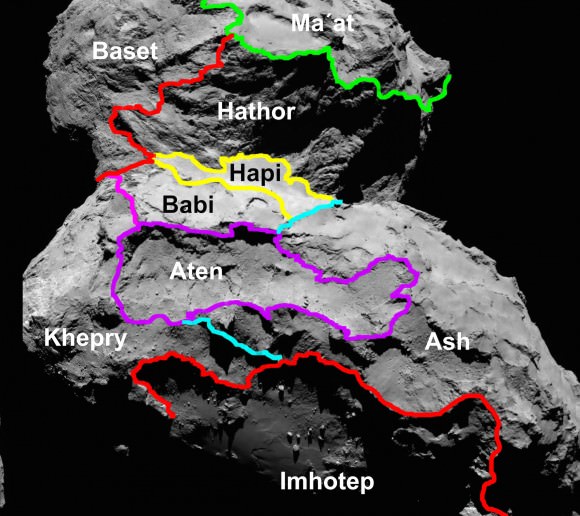
Aten has a remarkably fresh floor free of dust. Nicolas Thomas, an OSIRIS camera co-investigator, speculates the depression may have formed as extreme changes in temperature experienced by the comet during its 6.5 year orbit around the Sun cracked and weakened the surface. Sublimating gas beneath the surface could then have explosively launched huge chunks of crust into space. Almost like watching an impact in reverse.
Every orbit, 67P it loses an estimated 1.1 million U.S. tons (3-5 billion kg) of material to space. To create the vast Aten chasm would have required some 10 to 20 orbits.
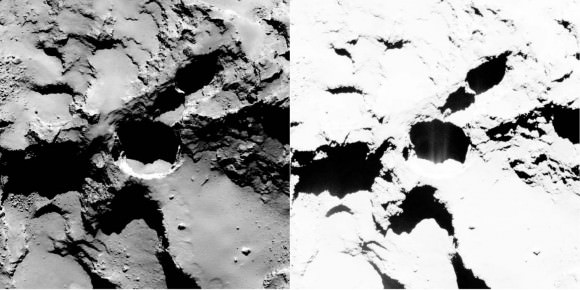
The neck of the comet, named Hapi, along with Imhotep and Anubis, are dominated by extremely smooth material (dust) with no obvious depressions and hardly a boulder. Along one side of Imhotep dozens of circular structures or pits several hundred meters across many of which appear to be filled with several meters of dust. Scientists suspect they were once active sites of vaporizing ices and are waiting to see if they might come alive again as the comet warms as it approaches its August perihelion.
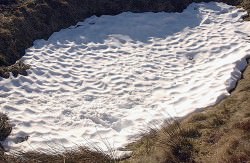
Close-up photos of one of the pits revealed that material had oozed out like a homemade vinegar and baking soda volcano hinting that pressures beneath the surface can rise high enough to convert the ice and dust into a fluid mix. Quiet for the moment, some pits may turn into smoking geysers when the time is right.
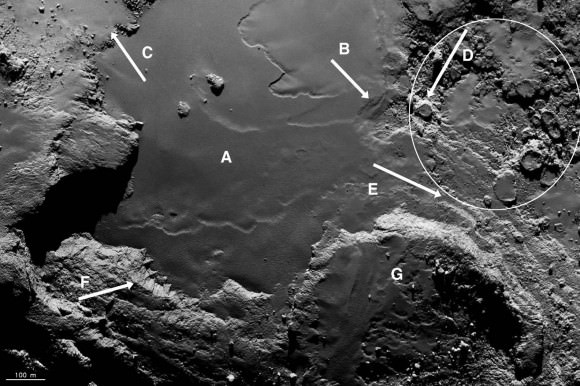
Pits may also have formed as “suncups” or depressions carved out by ice vaporizing in the Sun’s heat. If you’ve ever walked across a old snowfield, you’re probably familiar with their scooped appearance.
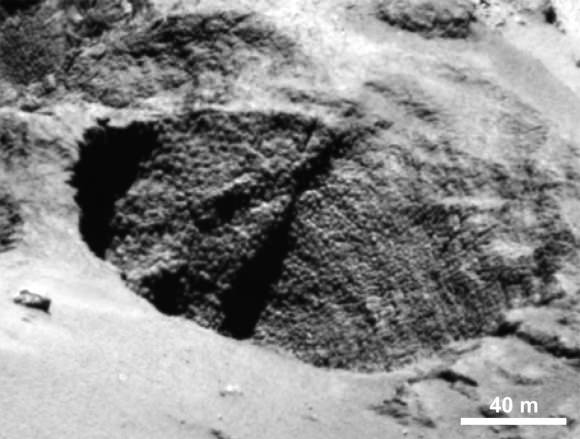
In what could be the most fascinating finding yet, walls in some of the pits are studded with 9-foot-diameter (3-m) nodules nicknamed “goosebumps” or “dinosaur eggs” that some researchers believe may be the original chunks of primitive matter that glommed together 4.5 billion years ago to create the comet. Seeing them reminds me of how we might build a fireplace by stacking and cementing wave-rounded boulders.
Though dominated by dust, the neck or Hapi region was the primary source of water outgassing when Rosetta pulled up to the comet last August. Further study as 67P becomes more active on its approach to the Sun show many more sources. Some release primarily water vapor, others carbon monoxide or carbon dioxide gas that vary according to season and Sun exposure.
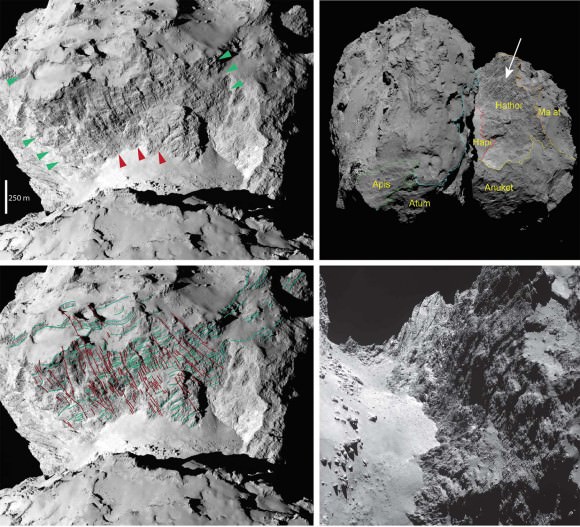
The grandest of the consolidated surfaces – the fifth type of terrain – is Hathor, a towering 2,950-foot (900 meter) cliff that dominates the underside of the comet’s duck-like head. Its distinctive linear features, which run both up and down and across for much of its height, reveal brighter material that suggests we’re seeing the internal structure of the comet’s head. Tucked along an alcove on the cliff are additional bright white spots less than 30 feet (10-m) across that may be patches of sublimating ice.
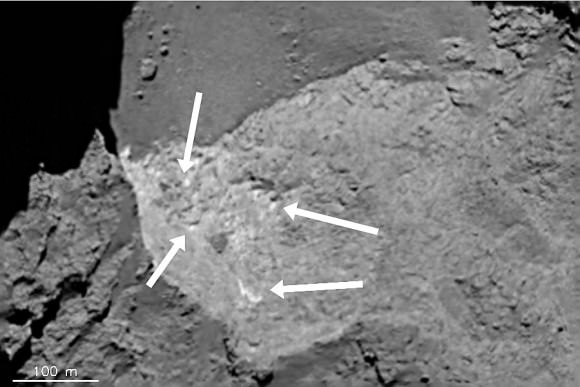
Another region named Anuket borders Hathor and exhibits significant cracks that may have formed from stress induced by the comet’s rotation. For a complete synopsis of what these cracks could mean for 67P’s future, please check out Universe Today’s Tim Reyes’ article on the topic.
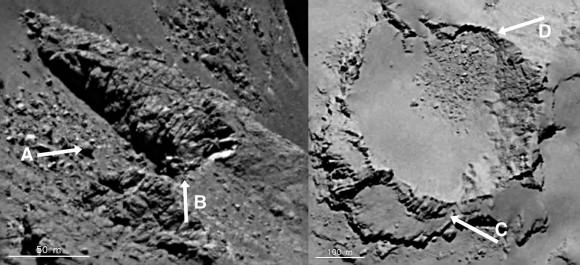
Using a spectrometer to scan the comet’s surface researchers discovered complex organic (carbon-based) molecules that could include carboxylic acids – a component of amino acids. These organics only form in deep space where cosmic rays and ultraviolet light strike ice-coated dust to energize the creation of new compounds. Finding them in 67P could indicate that the comet formed farther from the Sun than expected and therefore may be more pristine than other comets. Finally, water vapor given off by 67P has been analyzed and discovered to have a higher amount of deuterium to hydrogen compared to water on Earth, indicating that 67P and its brethren were probably not responsible for seeding our planet’s oceans.
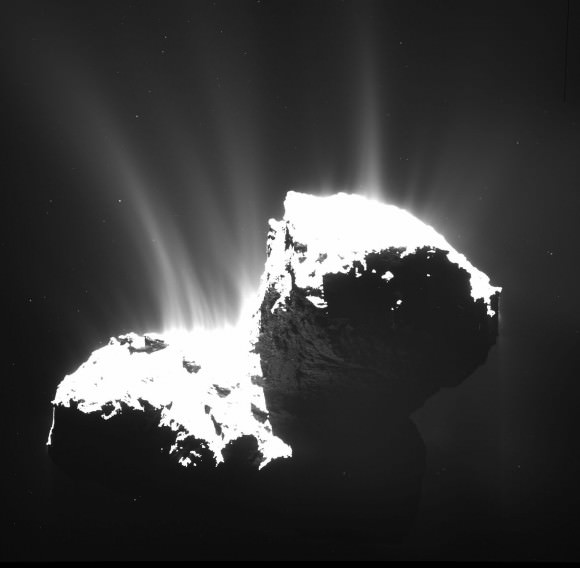
Credits: ESA/Rosetta/MPS for OSIRIS Team MPS/UPD/LAM/IAA/SSO/INTA/UPM/DASP/IDA
Churyumov-Gerasimenko is active right now and will only become more so as it approaches perihelion this summer. Expect the landscape to transform before our eyes. Cliffs that look solid now will give way and crumble, pits will break their silence and erupt as geysers as chunks of comet take flight. Here on Earth the tumult will reveal itself as an delicate coma followed by the streak of a tail.
Below you’ll find links that will take you to all the papers in Science and a wonderful website filled with hi-resolution images of Rosetta’s comet:

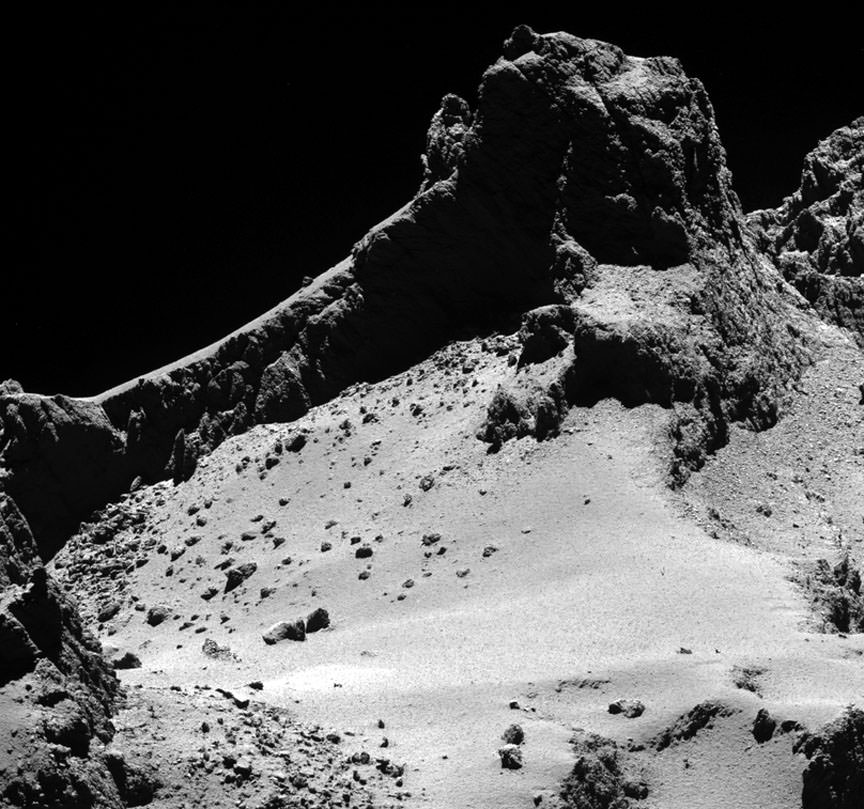
Excellent article. So many of these comet-scapes remind me of 50s or 60s era space art and science fiction movies. Robinson Crusoe on Mars. How many directors would love this comet to film on location? Keeping everything on the comet and not flying off like Philae would certainly be a constant problem. This comet would be the equivalent of Alabama Hills in Owens Valley for westerns movies – for making of classic space westerns.
Thanks Tim. I hadn’t considered it but you’re right. Especially that first image – something Bonestell about it.
It is fascinating to now get a truly close look at one of Fred Whipple’s dirty snowballs – and to find out once and forall what sort of dirt is there! (The snow would be obvious.)
Thank you for a superb summary, Bob!
Pete, I wouldn’t be surprised about a certain variety in comet material. Because we’ve kinda “landed” on one doesn’t tell us automatically about the billions of others.
Hey Pete, thank you. Whipple would have been thrilled. He at least got to see images from the Halley and Stardust missions. I think he would have been surprised how sparse ice is on 67P’s surface. Back when he proposed his theory, comets were always depicted as snowy white snowballs. Now we know how dark and “dirty” they are.
This article has got to be among the top 10 stories I’ve read at UT! Great stuff Bob!
In a perfect world.. we’d launch dozens of probes to comets and asteroids every year. That said, this in situ sampling is hopefully the first of many such missions! GO Rosetta!
Aqua,
That is high praise. Thank you for such a nice compliment. Glad you enjoyed it.
Great article I must agree with Aqua4u this is right at the top and the Pictures (forgive the pun) are out of this world, Fair play for Bob he always comes up with a nice surprise..Thanks Bob 🙂
UFOsM,
Thank you! It’s so much about the photos. We’ve seen so few taken with the OSIRIS narrow angle camera. The more the merrier!
It’s one of the best articles I’ve read, thus far.
But this triggered something when “impact craters” were mentioned…
Something deep (no pun intended).
http://www.esa.int/spaceinimages/Images/2014/10/Comet_on_2_October_NavCam
http://www.esa.int/spaceinimages/Images/2014/10/Comet_on_28_October_NavCam
http://www.esa.int/spaceinimages/Images/2015/01/Impact_crater_candidate
And those are just a few of the lowly and greatly under-appreciated Rosetta’s NAVCAM images…
great article sir. nice job!